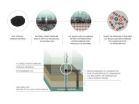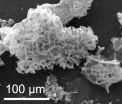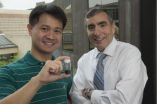(Press-News.org) HOUSTON – (June 3, 2014) – Rice University scientists have created an Earth-friendly way to separate carbon dioxide from natural gas at wellheads.
A porous material invented by the Rice lab of chemist James Tour sequesters carbon dioxide, a greenhouse gas, at ambient temperature with pressure provided by the wellhead and lets it go once the pressure is released. The material shows promise to replace more costly and energy-intensive processes.
Results from the research appear today in the journal Nature Communications.
Natural gas is the cleanest fossil fuel. Development of cost-effective means to separate carbon dioxide during the production process will improve this advantage over other fossil fuels and enable the economic production of gas resources with higher carbon dioxide content that would be too costly to recover using current carbon capture technologies, Tour said. Traditionally, carbon dioxide has been removed from natural gas to meet pipelines' specifications.
The Tour lab, with assistance from the National Institute of Standards and Technology (NIST), produced the patented material that pulls only carbon dioxide molecules from flowing natural gas and polymerizes them while under pressure naturally provided by the well.
When the pressure is released, the carbon dioxide spontaneously depolymerizes and frees the sorbent material to collect more.
All of this works in ambient temperatures, unlike current high-temperature capture technologies that use up a significant portion of the energy being produced.
"If the oil and gas industry does not respond to concerns about carbon dioxide and other emissions, it could well face new regulations," Tour said, noting the White House issued its latest National Climate Assessment last month and, this week, set new rules to cut carbon pollution from the nation's power plants.
"Our technique allows one to specifically remove carbon dioxide at the source. It doesn't have to be transported to a collection station to do the separation," he said. "This will be especially effective offshore, where the footprint of traditional methods that involve scrubbing towers or membranes are too cumbersome.
"This will enable companies to pump carbon dioxide directly back downhole, where it's been for millions of years, or use it for enhanced oil recovery to further the release of oil and natural gas. Or they can package and sell it for other industrial applications," he said.
The Rice material, a nanoporous solid of carbon with nitrogen or sulfur, is inexpensive and simple to produce compared with the liquid amine-based scrubbers used now, Tour said. "Amines are corrosive and hard on equipment," he said. "They do capture carbon dioxide, but they need to be heated to about 140 degrees Celsius to release it for permanent storage. That's a terrible waste of energy."
Rice graduate student Chih-Chau Hwang, lead author of the paper, first tried to combine amines with porous carbon. "But I still needed to heat it to break the covalent bonds between the amine and carbon dioxide molecules," he said. Hwang also considered metal oxide frameworks that trap carbon dioxide molecules, but they had the unfortunate side effect of capturing the desired methane as well and they are far too expensive to make for this application.
The porous carbon powder he settled on has massive surface area and turns the neat trick of converting gaseous carbon dioxide into solid polymer chains that nestle in the pores.
"Nobody's ever seen a mechanism like this," Tour said. "You've got to have that nucleophile (the sulfur or nitrogen atoms) to start the polymerization reaction. This would never work on simple activated carbon; the key is that the polymer forms and provides continuous selectivity for carbon dioxide."
Methane, ethane and propane molecules that make up natural gas may try to stick to the carbon, but the growing polymer chains simply push them off, he said.
The researchers treated their carbon source with potassium hydroxide at 600 degrees Celsius to produce the powders with either sulfur or nitrogen atoms evenly distributed through the resulting porous material. The sulfur-infused powder performed best, absorbing 82 percent of its weight in carbon dioxide. The nitrogen-infused powder was nearly as good and improved with further processing.
Tour said the material did not degrade over many cycles, "and my guess is we won't see any. After heating it to 600 degrees C for the one-step synthesis from inexpensive industrial polymers, the final carbon material has a surface area of 2,500 square meters per gram, and it is enormously robust and extremely stable."
INFORMATION: Apache Corp., a Houston-based oil and gas exploration and production company, funded the research at Rice and licensed the technology. Tour expected it will take time and more work on manufacturing and engineering aspects to commercialize.
The paper's co-authors are undergraduate Josiah Tour, research scientist Carter Kittrell and senior research scientist Lawrence Alemany, all of Rice, and Laura Espinal, an associate at NIST. Tour is the T.T. and W.F. Chao Chair in Chemistry as well as a professor of mechanical engineering and nanoengineering and of computer science.
Editor's note: Links to videos, a graphic and images for download appear at the end of this release.
David Ruth
713-348-6327
david@rice.edu
Mike Williams
713-348-6728
mikewilliams@rice.edu
Watch videos about the project by clicking the images above.
Read the abstract at http://dx.doi.org/10.1038/ncomms4961
This news release can be found online at news.rice.edu.
Follow Rice News and Media Relations via Twitter @RiceUNews
Related Materials:
Tour Group: http://www.jmtour.com
Richard E. Smalley Institute for Nanoscale Science and Technology: http://smalley.rice.edu
Images for download:
http://news.rice.edu/wp-content/uploads/2014/05/CO2_Polymer.jpg
Illustration shows the carbon polymerization process created at Rice University. Illustration by Tanyia Johnson/Rice University. Click the link for a larger image. A high-resolution PDF is available upon request.
http://news.rice.edu/wp-content/uploads/2014/05/0527_CARBON-1-web.jpg
Graduate student Chih-Chau Hwang, left, and Professor James Tour show a vial of material that has the ability to capture carbon from gas flowing out of a well and hold it until it can be put back underground or otherwise used. (Credit: Jeff Fitlow/Rice University)
http://news.rice.edu/wp-content/uploads/2014/05/0527_CARBON-2-web.jpg
Particles of nitrogen-containing porous carbon are able to capture carbon dioxide from natural gas under pressure at a wellhead by polymerizing it, according to researchers at Rice University. When the pressure is released, the carbon dioxide returns to gaseous form. (Credit: Tour Group/Rice University)
Located on a 300-acre forested campus in Houston, Rice University is consistently ranked among the nation's top 20 universities by U.S. News & World Report. Rice has highly respected schools of Architecture, Business, Continuing Studies, Engineering, Humanities, Music, Natural Sciences and Social Sciences and is home to the Baker Institute for Public Policy. With 3,920 undergraduates and 2,567 graduate students, Rice's undergraduate student-to-faculty ratio is 6.3-to-1. Its residential college system builds close-knit communities and lifelong friendships, just one reason why Rice has been ranked No. 1 for best quality of life multiple times by the Princeton Review and No. 2 for "best value" among private universities by Kiplinger's Personal Finance. To read "What they're saying about Rice," go here.
Rice University produces carbon-capture breakthrough
Porous material polymerizes carbon dioxide at natural gas wellheads
2014-06-03
ELSE PRESS RELEASES FROM THIS DATE:
Opioid overdose prevention programs may reduce deaths, reports Journal of Addiction Medicine
2014-06-03
June 3, 2014 – Community opioid overdose prevention programs (OOPPs)—including the use of naloxone for rapid drug reversal—can improve bystander responses to overdose of heroin and related drugs, according to a review in the June Journal of Addiction Medicine, the official journal of the American Society of Addiction Medicine. The journal is published by Lippincott Williams & Wilkins, a part of Wolters Kluwer Health .
Based on the available evidence, "Bystanders (mostly opioid users) can and will use naloxone to reverse opioid overdoses when properly trained, and…this ...
Prototype electrolyte sensor to provide immediate read-outs
2014-06-03
ALBUQUERQUE, N.M. — Patients trying to navigate today's complex medical system with its costly laboratory analyses might prefer a pain-free home diagnostic device, worn on the wrist, that can analyze, continuously record and immediately remedy low electrolyte levels.
Runners, athletes in other strenuous sports and soldiers on long missions also might prefer immediate knowledge of their electrolytic states as an aid to improved performance. Electrolytes such as potassium, calcium, magnesium and other salts are key in carrying nerve impulses that tell the heart and other ...
Climate change at the movies
2014-06-03
Research published in the International Journal of Sustainable Development suggests that purportedly entertaining films that feature global warming and climate change can affect public understanding. But films are often bound up in problematic and limiting identity politics, which commonly reiterate racial, gender and sexual stereotypes positioning as they do white men as being the decision makers and the voice of authority.
Bridie McGreavy and Laura Lindenfeld of the Department of Communication and Journalism at the University of Maine, have analyzed three films that ...
NASA infrared imagery sees heavy rain potential in Tropical Depression 2E
2014-06-03
NASA's Aqua satellite captured an infrared image of Tropical Depression 2E that revealed high, very cold cloud top temperatures. Strong thunderstorms with cold cloud top temperatures that reach high into the troposphere have the potential to drop heavy rainfall amounts, and the National Hurricane Center has forecast large rainfall for the southern region of Mexico over the next couple of days.
A Tropical Storm Warning is in effect for Salina Cruz to the Mexico and Guatemala border as the depression remained stationary near the southwestern coast of Mexico on June 3.
NASA's ...
Farmers markets inspire WIC moms, but grocery-store produce costs less!
2014-06-03
URBANA, Ill. – When participants in a local Women, Infants, and Children (WIC) program received vouchers for fruits and vegetables at area farmers markets, they ate a greater variety of vegetables and more often chose fruits or vegetables as snacks. But a survey comparing prices at grocery stores and farmers markets showed that better produce prices could be found in local supermarkets, says a new University of Illinois study.
"The biggest effect the vouchers had was related to the quality of participants' diets. Those who used the farmers market vouchers ate a greater ...
NIH task force proposes standards for research on chronic low back pain
2014-06-03
June 3, 2014 - Standardized research methods are needed to make greater progress toward reducing the high burden and costs of chronic low back pain (cLBP), according to a Task Force report in the June 15 issue of Spine. The journal is published by Lippincott Williams & Wilkins, a part of Wolters Kluwer Health.
The article introduces a set of proposed research standards to help in comparing the results of cLBP studies. The recommendations were developed by a Research Task Force convened by the NIH Pain Consortium. The Task Force co-chairs were Drs Richard A. Deyo of ...
Brain signals link physical fitness to better language skills in kids
2014-06-03
CHAMPAIGN, Ill. — Children who are physically fit have faster and more robust neuro-electrical brain responses during reading than their less-fit peers, researchers report.
These differences correspond with better language skills in the children who are more fit, and occur whether they're reading straightforward sentences or sentences that contain errors of grammar or syntax.
The new findings, reported in the journal Brain and Cognition, do not prove that higher fitness directly influences the changes seen in the electrical activity of the brain, the researchers say, ...
Palmer amaranth threatens Midwest farm economy, researchers report
2014-06-03
CHAMPAIGN, Ill. — An invasive weed that has put some southern cotton farmers out of business is now finding its way across the Midwest – and many corn and soybean growers don't yet appreciate the threat, University of Illinois researchers report.
Palmer amaranth (Amaranthus palmeri), a flowering plant native to the Sonoran desert and southwest United States, has a laundry list of traits that make it a fierce competitor on the farm, said Aaron Hager, a University of Illinois crop sciences professor.
Palmer amaranth germinates throughout much of the growing season, starts ...
Toxic computer waste in the developing world
2014-06-03
As the developing world continues to develop, standards of living and access to technology increases. Unfortunately, as personal computers, laptops and mobile phones become increasingly common so the problem of recycling and disposal of such devices when they become technologically obsolete rises too, according to research published in the International Journal of Environmental Technology and Management.
Neelu Jain of the PEC University of Technology, in Chandigarh and Pamela Chawla of the Surya World, Surya World Technical Campus in Punjab, India, have estimated the ...
Nano-platform ready: Scientists use DNA origami to create 2-D structures
2014-06-03
Scientists at New York University and the University of Melbourne have developed a method using DNA origami to turn one-dimensional nano materials into two dimensions. Their breakthrough, published in the latest issue of the journal Nature Nanotechnology, offers the potential to enhance fiber optics and electronic devices by reducing their size and increasing their speed.
"We can now take linear nano-materials and direct how they are organized in two dimensions, using a DNA origami platform to create any number of shapes," explains NYU Chemistry Professor Nadrian Seeman, ...
LAST 30 PRESS RELEASES:
Tracing the quick synthesis of an industrially important catalyst
New software sheds light on cancer’s hidden genetic networks
UT Health San Antonio awarded $3 million in CPRIT grants to bolster cancer research and prevention efforts in South Texas
Third symposium spotlights global challenge of new contaminants in China’s fight against pollution
From straw to soil harmony: International team reveals how biochar supercharges carbon-smart farming
Myeloma: How AI is redrawing the map of cancer care
Manhattan E. Charurat, Ph.D., MHS invested as the Homer and Martha Gudelsky Distinguished Professor in Medicine at the University of Maryland School of Medicine
Insilico Medicine’s Pharma.AI Q4 Winter Launch Recap: Revolutionizing drug discovery with cutting-edge AI innovations, accelerating the path to pharmaceutical superintelligence
Nanoplastics have diet-dependent impacts on digestive system health
Brain neuron death occurs throughout life and increases with age, a natural human protein drug may halt neuron death in Alzheimer’s disease
SPIE and CLP announce the recipients of the 2025 Advanced Photonics Young Innovator Award
Lessons from the Caldor Fire’s Christmas Valley ‘Miracle’
Ant societies rose by trading individual protection for collective power
Research reveals how ancient viral DNA shapes early embryonic development
A molecular gatekeeper that controls protein synthesis
New ‘cloaking device’ concept to shield sensitive tech from magnetic fields
Researchers show impact of mountain building and climate change on alpine biodiversity
Study models the transition from Neanderthals to modern humans in Europe
University of Phoenix College of Doctoral Studies releases white paper on AI-driven skilling to reduce burnout and restore worker autonomy
AIs fail at the game of visual “telephone”
The levers for a sustainable food system
Potential changes in US homelessness by ending federal support for housing first programs
Vulnerability of large language models to prompt injection when providing medical advice
Researchers develop new system for high-energy-density, long-life, multi-electron transfer bromine-based flow batteries
Ending federal support for housing first programs could increase U.S. homelessness by 5% in one year, new JAMA study finds
New research uncovers molecular ‘safety switch’ shielding cancers from immune attack
Bacteria resisting viral infection can still sink carbon to ocean floor
Younger biological age may increase depression risk in older women during COVID-19
Bharat Innovates 2026 National Basecamp Showcases India’s Most Promising Deep-Tech Ventures
Here’s what determines whether your income level rises or falls
[Press-News.org] Rice University produces carbon-capture breakthroughPorous material polymerizes carbon dioxide at natural gas wellheads






